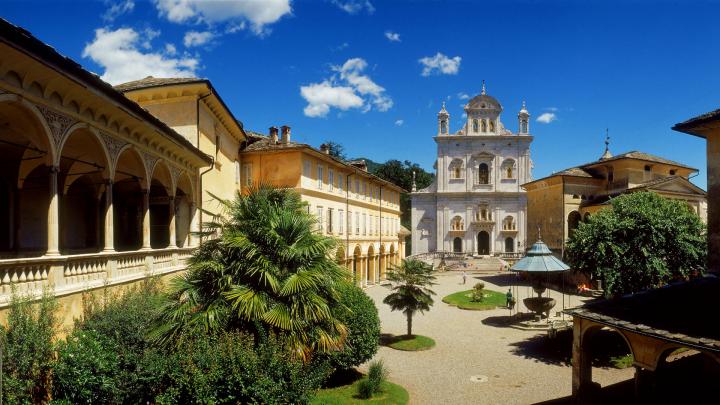LIST OF WHL WORLD HERITAGE SITES
The identification, protection, conservation and passing down to future generations of cultural and natural heritage across the world: this is one of UNESCO’s chief missions. Heritage refers to the legacy of our past, which we enjoy today and which we pass onto future generations. Our heritage, be it cultural or natural, is an irreplaceable source of life and inspiration. The Convention Concerning the Protection of the World’s Cultural and Natural Heritage, adopted by UNESCO in 1972, dictates that candidates may be added to the World Heritage List as “Cultural heritage”, “Natural heritage” and mixed cultural and natural sites.
Piedmont boasts 5 such sites:
- Residences of the Royal House of Savoy (1997)
- Sacri Monti of Piemonte and Lombardia (2003)
- Prehistoric pile dwellings around the Alps (2011)
- Vineyard Landscape of Piedmont: Langhe-Roero and Monferrato (2014)
- Ivrea, industrial city of the 20th century (2018)
INTANGIBLE CULTURAL HERITAGE
UNESCO has among its priority objectives the implementation of measures to encourage the transmission of intangible cultural heritage between generations. For this reason, in 2003 it adopted the Convention for the Safeguarding of the Intangible Cultural Heritage, ratified by Italy in 2007, which provides for a series of procedures for the identification, preservation, promotion and enhancement of intangible cultural heritage.
The candidate element, for whose inscription is a fundamental criterion the representativeness of diversity and human creativity, must possess some very specific characteristics, including: to be transmitted from generation to generation; to be constantly recreated by communities in close correlation with the surrounding environment and its history; to promote respect for cultural diversity and human creativity.
In Piedmont:
- Art of dry stone walling, knowledge and techniques (2018)
- Alpinism (2019)
- Musical art of horn players (2020)
- Truffle hunting and extraction in Italy, traditional knowledge and practice (2021)
BIOSPHERE RESERVES
The Man and the Biosphere – MAB programme is an intergovernmental scientific project launched by UNESCO in 1971, which aims to foster a harmonious relationship between man and the environment through the conservation of biodiversity and the good practices of Sustainable Development. The Programme aims to improve the relationship between people and the environment in which they live, promoting innovative approaches to the economic development that are both socially and culturally appropriate and environmentally sustainable. The Reserves promote cooperative scientific activities, interdisciplinary research and environmental sustainability through the comprehensive involvement of local communities; they therefore serve as best practice examples for sustainable development and the interaction between social and ecological systems.
Each Reserve of the Biosphere has to include three interdependent areas:
• the “core-area”, where human activities are limited and the main priorities are the protection and long-lasting preservation of natural habitats and communities found within;
• the “buffer zone” which surrounds or borders power stations, where only activities compatible with conservation may be undertaken, including environmental education, ecotourism, monitoring and scientific research;
• the “transition zone”, where economic and social activities must aim towards the execution of projects and good conduct regarding sustainable development, in order to benefit the local population.
The World Network of Biosphere Reserves currently includes 19 reserves in Italy. The following are found in Piedmont:
- MAB Valle del Ticino Val Grande Verbano (2002, expanded in 2018)
- MAB Monviso (2013)
- MAB Collina Po (2016)
UNESCO GLOBAL GEOPARKS
UNESCO Global Geoparks - unique geographical areas whose sites and landscapes are of international geological value from the point of view of a holistic approach to conservation, education and sustainable development - have been recognised within the scope of the "International Geoscience and Geoparks Programme" launched by UNESCO in 2015. In the Geoparks - the primary objective of which is to protect biodiversity -, conservation efforts are combined with sustainable development and the involvement of local communities.
UNESCO Global Geoparks strive to increase awareness and knowledge regarding the role and importance of geodiversity, and to promote best practices as they relate to conservation, education, dissemination and tourism-related use of geological heritage. Together with World Heritage List (WHL) sites and Biosphere Reserves (MAB), the UNESCO Global Geoparks form a comprehensive collection of tools for the promotion of sustainable development, acting on both global and local levels.
The following are found in Piedmont:
- Geoparco Sesia Val Grande (2013)
UNESCO CREATIVE CITIES
The UNESCO Creative Cities Network is a UNESCO programme set up in 2004 to recognise the key role of cultural and creative industries in sustainable urban development, a vision that has been confirmed and reinforced through the implementation of the Convention for the Protection and Promotion of Diversity of Cultural Expression in 2005 and through the Sustainable Development Agenda 2030.
The cities that make up the network - divided into seven areas corresponding to seven cultural sectors (Music, Literature, Handicrafts and Folk Art, Design, Media Arts, Gastronomy, Cinema) – develop and experiment with innovative methods to include creativity within their territorial strategies and increase the impact of culture on urban development.
All the Creative Cities are committed to the development and exchange of good innovative practices in order to reinforce the participation in cultural life and to integrate culture in their development policies. In this way, the Creative Cities contribute to reaching the Objectives of sustainable development established by the Uniited Nations’ Agenda 2030.
In Piedmont:
- Torino Creative City of Design (2014)
- Alba Creative City of Gastronomy (2017)
- Biella Creative Cities of Crafts&Folk Art (2019)
UNESCO World Heritage in Piedmont

